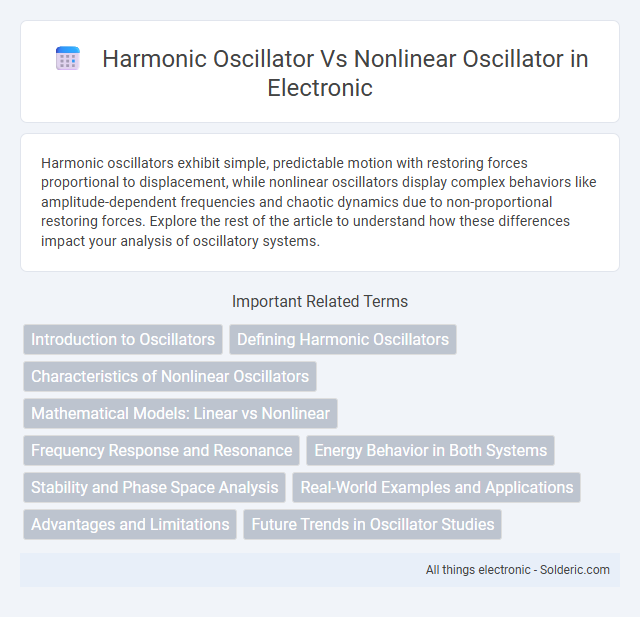Harmonic oscillators exhibit simple, predictable motion with restoring forces proportional to displacement, while nonlinear oscillators display complex behaviors like amplitude-dependent frequencies and chaotic dynamics due to non-proportional restoring forces. Explore the rest of the article to understand how these differences impact your analysis of oscillatory systems.
Comparison Table
| Feature | Harmonic Oscillator | Nonlinear Oscillator |
|---|---|---|
| Definition | Oscillator with linear restoring force proportional to displacement | Oscillator with restoring force dependent on displacement nonlinearly |
| Equation of Motion | mx'' + kx = 0 | mx'' + f(x) = 0, where f(x) is nonlinear |
| Superposition Principle | Valid | Invalid |
| Frequency | Constant, independent of amplitude | Amplitude-dependent frequency |
| Solution Type | Sinusoidal, simple analytic solution | Complex, often requires numerical methods |
| Examples | Mass-spring system, LC circuit | Pendulum at large angles, Van der Pol oscillator |
| Energy Behavior | Conserved in ideal case | Can show energy transfer among modes, chaos |
Introduction to Oscillators
Oscillators generate periodic signals essential in various applications, with harmonic oscillators producing sinusoidal waves characterized by linear restoring forces and constant frequency. Nonlinear oscillators exhibit complex behaviors including amplitude-dependent frequencies, bifurcations, and chaos due to their nonlinear restoring forces. Your understanding of these fundamental differences aids in selecting the appropriate oscillator for signal generation in electronics, physics, and engineering.
Defining Harmonic Oscillators
Harmonic oscillators are systems in physics and engineering characterized by a restoring force proportional to displacement, resulting in simple sinusoidal motion with constant frequency and amplitude. Unlike nonlinear oscillators, harmonic oscillators follow linear differential equations, enabling predictable and stable oscillations essential for timekeeping, signal processing, and mechanical systems. Your understanding of harmonic oscillators provides the foundation for analyzing more complex nonlinear behaviors encountered in advanced scientific applications.
Characteristics of Nonlinear Oscillators
Nonlinear oscillators exhibit amplitude-dependent frequencies, complex dynamics including bifurcations and chaos, and energy exchange between modes unlike harmonic oscillators with constant frequency and linear restoring forces. Your system's behavior can become sensitive to initial conditions, resulting in unpredictable or multi-stable states. Nonlinear characteristics enable rich phenomena such as limit cycles and frequency entrainment, critical for advanced applications in physics and engineering.
Mathematical Models: Linear vs Nonlinear
Harmonic oscillators are described by linear differential equations, such as the simple harmonic motion equation \( m \frac{d^2x}{dt^2} + kx = 0 \), where the restoring force is proportional to displacement, leading to predictable sinusoidal solutions. Nonlinear oscillators involve nonlinear differential equations that include terms like \( x^3 \) or velocity-dependent damping, resulting in complex, often chaotic behavior that standard linear superposition cannot solve. Understanding your system's mathematical model is critical for predicting oscillatory behavior, stability, and response under varying initial conditions.
Frequency Response and Resonance
Harmonic oscillators exhibit a linear frequency response with a single, well-defined resonance peak at their natural frequency, resulting in predictable oscillations and energy transfer. Nonlinear oscillators, however, display complex frequency responses with multiple resonance peaks, amplitude-dependent frequencies, and phenomena like bifurcations or chaos, making their behavior less predictable. Understanding these differences helps you optimize systems that rely on specific resonance characteristics for enhanced performance or stability.
Energy Behavior in Both Systems
In a harmonic oscillator, energy oscillates between kinetic and potential forms with a constant total energy, exhibiting predictable, periodic motion. Nonlinear oscillators demonstrate complex energy behavior where total energy can vary due to amplitude-dependent frequencies and potential energy landscapes, often leading to phenomena such as energy transfer, bifurcations, or chaos. Energy dissipation or external driving forces in nonlinear systems further complicate their dynamic energy distribution compared to the idealized harmonic oscillator.
Stability and Phase Space Analysis
Harmonic oscillators exhibit stable, periodic motion characterized by closed elliptical trajectories in phase space, reflecting constant energy and predictable dynamics. Nonlinear oscillators display diverse stability behaviors, including limit cycles, bifurcations, and chaotic attractors, resulting in complex, often non-elliptical phase space patterns. Stability analysis of nonlinear oscillators involves examining fixed points, Lyapunov exponents, and Poincare maps to understand transitions between stable and unstable regimes.
Real-World Examples and Applications
Harmonic oscillators, such as pendulums and mass-spring systems, are widely used in clocks, musical instruments, and simple electrical circuits where predictable periodic motion is essential. Nonlinear oscillators appear in real-world systems like heartbeats, climate dynamics, and electronic circuits exhibiting chaos, where amplitude or frequency varies with system state. Understanding your application's needs helps determine whether the stability of harmonic oscillators or the complex, adaptive behavior of nonlinear oscillators is more suitable.
Advantages and Limitations
Harmonic oscillators offer simplicity and predictable sinusoidal motion, making them ideal for modeling ideal systems and facilitating analytical solutions. Nonlinear oscillators can capture complex behaviors like chaos and bifurcations, providing a more accurate representation of real-world phenomena where linear assumptions fail. Your choice depends on whether you prioritize mathematical tractability or the ability to model intricate, real-life oscillatory dynamics.
Future Trends in Oscillator Studies
Future trends in oscillator studies emphasize advancements in nonlinear oscillator research due to their complex dynamics and wide applications in fields like neural networks and quantum computing. Harmonic oscillators remain fundamental for theoretical models and precision engineering, while emerging technologies drive exploration of chaos control and synchronization in nonlinear systems. Your understanding of these evolving concepts can enhance design strategies in modern signal processing and adaptive systems.
Harmonic oscillator vs Nonlinear oscillator Infographic

 solderic.com
solderic.com